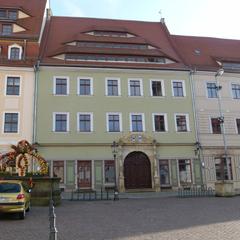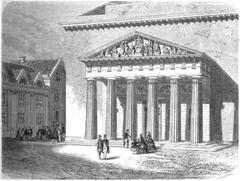
Zwinger Visiting Hours, Tickets, and Historical Sites in Pirna
Date: 19/07/2024
Introduction to Zwinger
The Zwinger in Pirna, Germany, stands as a remarkable testament to Renaissance military architecture and the rich history of the region. Constructed in the 16th century, the Zwinger was initially part of Pirna’s defensive system, strategically located on the Elbe River to protect the town from invaders during turbulent periods such as the Thirty Years’ War and the Seven Years’ War (Discover the Zwinger in Pirna). This historical site not only offers an intriguing glimpse into the past but also serves as a cultural hub, hosting events and exhibitions that celebrate the heritage of Pirna. This comprehensive guide aims to provide all essential information for potential visitors, from visiting hours and ticket prices to nearby attractions and travel tips, ensuring a memorable and enriching experience at the Zwinger.
Table of Contents
- [Introduction](#introductionintroduction)
- [Early Beginnings](#early-beginningsearly-beginnings)
- [Historical Significance](#historical-significancehistorical-significance)
- [Architectural Significance](#architectural-significancearchitectural-significance)
- [Cultural Significance](#cultural-significancecultural-significance)
- [Modern-Day Significance](#modern-day-significancemodern-day-significance)
- [Visitor Information](#visitor-informationvisitor-information)
- [Visiting Hours](#visiting-hoursvisiting-hours)
- [Tickets](#ticketstickets)
- [Guided Tours](#guided-toursguided-tours)
- [Accessibility](#accessibilityaccessibility)
- [Photography](#photographyphotography)
- [Nearby Attractions](#nearby-attractionsnearby-attractions)
- [Special Events](#special-eventsspecial-events)
- [FAQ](#faqfaq)
- [Conclusion](#conclusionconclusion)
- [References and Further Reading](#references-and-further-readingreferences-and-further-reading)
Early Beginnings
The Zwinger, dating back to the 16th century, was originally constructed as part of Pirna’s defensive system. It was built to protect the town from invaders, leveraging its strategic location on the Elbe River.
Historical Significance
The Zwinger in Pirna, Germany, is a remarkable example of Renaissance military architecture. Constructed in the 16th century, it served as a defensive bastion for the town of Pirna, which was strategically important due to its location on the Elbe River. The Zwinger was part of a larger fortification system designed to protect the town from invaders, particularly during the turbulent periods of the Thirty Years’ War and other regional conflicts.
The structure’s historical significance is further underscored by its role in the Seven Years’ War. During this period, the Zwinger was occupied by various military forces, including the Prussians and Austrians, who recognized its strategic importance. The fortifications were continually updated and reinforced, reflecting the evolving nature of military engineering and the ongoing need for robust defenses.
Architectural Significance
Architecturally, the Zwinger is a testament to the ingenuity and craftsmanship of Renaissance builders. The structure features thick walls, bastions, and a moat, all designed to withstand artillery fire and sieges. The use of local sandstone in its construction not only provided durability but also contributed to the aesthetic appeal of the fortifications.
One of the most striking features of the Zwinger is its integration with the natural landscape. The fortifications were built to take advantage of the natural topography, with the Elbe River providing a natural barrier on one side. This strategic use of the landscape is a hallmark of Renaissance military architecture and demonstrates the advanced understanding of defensive principles at the time.
Cultural Significance
The Zwinger is not just a historical and architectural landmark; it also holds significant cultural value for the town of Pirna and the surrounding region. Over the centuries, it has been a symbol of the town’s resilience and strategic importance. Today, it serves as a cultural hub, hosting various events, exhibitions, and performances that celebrate the rich history and heritage of Pirna.
The Zwinger is also a popular tourist attraction, drawing visitors from around the world who are interested in history, architecture, and culture. Its preservation and restoration have been a priority for local authorities, ensuring that future generations can continue to appreciate its significance.
Modern-Day Significance
In contemporary times, the Zwinger has taken on new roles while maintaining its historical essence. It has been repurposed to serve as a museum and cultural center, offering visitors a glimpse into the past through carefully curated exhibits and displays. The museum features artifacts and exhibits that highlight the history of Pirna, the Zwinger, and the broader region, providing valuable educational opportunities for both locals and tourists.
The Zwinger also plays a vital role in the community as a venue for cultural events, including concerts, theater performances, and festivals. These events not only enhance the cultural life of Pirna but also contribute to the local economy by attracting visitors and promoting tourism.
Visitor Information
Visiting Hours
The Zwinger is typically open to visitors from 10:00 AM to 6:00 PM. However, it’s advisable to check the official website for any changes in hours or special events that might affect accessibility.
Tickets
Ticket prices for the Zwinger vary depending on the type of visit. General admission is usually around €8, with discounts available for students, seniors, and groups. Special event tickets may have different pricing, so it’s best to consult the official website for the most current information.
Guided Tours
To fully appreciate the historical and architectural significance of the Zwinger, consider joining a guided tour. Knowledgeable guides provide in-depth information and fascinating anecdotes that bring the history of the site to life. Tours are available in multiple languages and can be booked in advance through the official website.
Accessibility
The Zwinger is accessible to visitors with mobility issues, with ramps and elevators available in key areas. However, some parts of the fortifications may be challenging to navigate due to the historical nature of the site. It is advisable to contact the visitor services in advance to discuss any specific needs or concerns.
Photography
Photography is generally allowed, but be mindful of any restrictions, especially in museum areas where flash photography may be prohibited to protect sensitive artifacts. For professional photography or special permissions, it is best to contact the administration in advance.
Nearby Attractions
While in Pirna, take the opportunity to explore other nearby attractions, such as the historic Old Town, the Elbe River promenade, and the nearby Saxon Switzerland National Park, which offers stunning natural landscapes and outdoor activities.
Dining Options
There are several dining options within and around the Zwinger. The on-site café offers a selection of light meals, snacks, and beverages, perfect for a quick break. For a more substantial meal, the town of Pirna has numerous restaurants and cafes serving both local and international cuisine. It is advisable to make reservations, especially during peak tourist seasons.
Souvenirs and Shopping
The Zwinger has a gift shop where you can purchase souvenirs, books, and other memorabilia related to the site. Additionally, the town of Pirna has several shops offering local crafts, antiques, and other unique items. Shopping in Pirna can be a delightful experience, providing a chance to take home a piece of local culture.
Safety and Etiquette
While visiting the Zwinger, it is important to follow all posted rules and guidelines to ensure the preservation of this historic site. Keep to designated paths, do not touch the exhibits, and dispose of trash properly. Be mindful of other visitors and maintain a respectful noise level, especially in indoor areas.
Language
While German is the primary language spoken in Pirna, many staff members at the Zwinger and local businesses speak English. It is still helpful to know a few basic German phrases, as this can enhance your experience and interactions with locals.
Emergency Contacts
In case of an emergency, dial 112 for medical assistance or 110 for police services. It is also a good idea to have the contact information for your country’s embassy or consulate in Germany. The visitor services at the Zwinger can also assist with any immediate concerns or emergencies.
Transportation
Pirna is well-connected by public transportation. The nearest major city is Dresden, which is about 20 kilometers away. From Dresden, you can take a regional train or bus to Pirna. The Zwinger is within walking distance from the Pirna train station. For those driving, there are parking facilities available near the site.
Accommodation
There are various accommodation options in Pirna, ranging from budget-friendly hostels to luxury hotels. Staying in the town allows for easy access to the Zwinger and other local attractions. Booking in advance is recommended, especially during peak tourist seasons.
Special Events
Throughout the year, the Zwinger hosts various special events, including historical reenactments, art exhibitions, and cultural festivals. These events offer unique opportunities to experience the site in different contexts and learn more about its historical and cultural significance.
FAQ
What are the Zwinger’s visiting hours?
The Zwinger is typically open from 10:00 AM to 6:00 PM. Check the official website for any updates or changes.
How much do tickets to the Zwinger cost?
General admission is usually around €8, with discounts available for students, seniors, and groups. Special event tickets may vary in price.
Are guided tours available?
Yes, guided tours are available and can be booked in advance. They offer in-depth information about the Zwinger’s history and architecture.
Is the Zwinger accessible to visitors with mobility issues?
Yes, the Zwinger is accessible with ramps and elevators in key areas, though some parts may be challenging due to the historical nature of the site.
Conclusion
The Zwinger in Pirna, Germany, is a site of immense historical, architectural, and cultural significance. Its rich history, impressive architecture, and ongoing role as a cultural hub make it a must-visit destination for anyone interested in the heritage of the region. By preserving and celebrating the Zwinger, Pirna continues to honor its past while enriching its present and future.
For more information and the latest updates, visit the official website. For more travel tips and updates on the Zwinger, download our mobile app Audiala, check out our other related posts, and follow us on social media.
References and Further Reading
- Discover the Zwinger in Pirna - History, Visiting Hours, Tickets, and More https://www.pirna.de/zwinger
- Complete Visitor Guide to Zwinger in Pirna, Germany https://www.zwinger.de/en/








